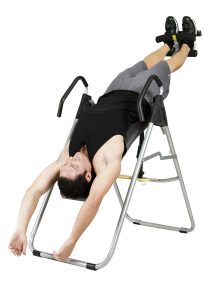If you’ve ever walked into someone’s home with a loved one hanging upside down on a table, you’ve experienced inversion therapy. As a form of self-preservation, everyone wants to stay healthy for as long as possible. Old age may set in, but there are many ways to keep up with your health without drugs or medications.
An inversion table is simply a platform that has secure locks for your ankles. Strap yourself into the ankle locks, and you can move the table to almost any angle. Hang completely upside down if you prefer. Knowing how often to use an inversion table is critical. Learn more about this tool so that you’re always safe and happily stretched out.

Starting Out Slow
When you’re new to inversion therapy, your spine needs a little bit of conditioning. Ideally, start out in a horizontal position. You’re laying down in a normal position with this starting point. Invert yourself to no more than 15 degrees for about 30 seconds. Perform this inversion for up to 10 times each day. Because the inversion angle is is very small, your body can take more decompression on a regular basis. The spinal discs receive a minor stretching that only improves their circulation over time.
Daily Frequency
Multiple Sessions Each Day
Major Benefits
Timing it Right
Considering Medical Issues
Frequency Importance
In the beginning stages, using your inversion table on a regular basis is important for a decompressed spine. The discs and joints find a “new normal” with their decompressed positions over time. However, they will settle into a compressed state if you stop inversion therapy altogether. Regular users eventually fall into a habit of inverting between one and three times a week. This frequency maintains the decompressed discs without too much strain on the surrounding muscles. Inverting for less time means that your discs will compress between each session. Maintain a once-a-week frequency at the very least.Depending on your age and medical issues, ask a loved one to spot you during the first few uses of the inversion table. Getting comfortable with the tool is part of the learning curve. Once you understand what works for your body, you can move ahead and deal with the process on an independent level. Inversion tables are safe tools as long as you respect the science behind the concept.
Which is the best time for me to use my inversion table.
1. Days I work out?
2. Off days?
3. Any days does not matter?